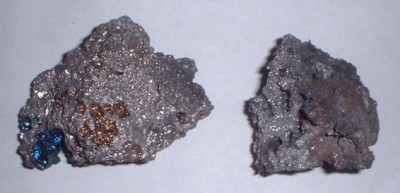Tamahagane steel
Nihontō swords were forged from the traditional tamahagane steel.
This type of steel can be identified from its peculiar appearance: a high quality tamahagane will usually have a shiny and silvery look, while a tamahagane of low quality will appear grayish. Sometimes, orange, blue or red dots can be observed. Those are not impurities, but the natural result of the oxidation process when the kera (see below) is set to cool out in the air. These are not the signs of a low-quality steel.
This type of steel can be identified from its peculiar appearance: a high quality tamahagane will usually have a shiny and silvery look, while a tamahagane of low quality will appear grayish. Sometimes, orange, blue or red dots can be observed. Those are not impurities, but the natural result of the oxidation process when the kera (see below) is set to cool out in the air. These are not the signs of a low-quality steel.

Japanese steel, called watetsu (European steel being called oranda tetsu) is created through the transformation of a ferruginous sand called satetsu. This sand originates from either magnetite (Fe3O4), marcasite (FeS2), or hematite (Fe2O3) and contains a large part of molybdenum, which prevent the steel from breaking. Beside this important quality for forging a blade, the sand also contains very few phosphorus and sulfur, which again, reduce the risk of breaking. There is actually two types of satetsu, the akame, which present a rusty color, and the masa or masago, which is thicker and black. The latter contains less impurities, such as phosphorus, and is the most suited for the making of a blade (mass proportion of phosphorus in akame 0.04, in masa 0.01; mass proportion of sulfur in akame 0.061, in masa 0.034 – data from a deposit in Izumo). This sand was found in abundance in the Hoki and Izumo regions. It was also praised for its high quality. Thus, many tatara furnaces could be found in these areas at the time. The tatara furnaces, also called low shaft furnaces, allowed a phenomenon of oxidation reduction: the carbon contained in the wood charcoal increased the carbon content of the steel. The goal was to extract the iron contained in the satetsu (which contains about 1% iron), turning it into a high carbon steel (steel is actually a type of iron containing more than 0.03% carbon). An incredibly hard steel is obtained, which, thanks to the natural properties of the ferruginous sand, will not become brittle. This type of steel can be sharpened very effectively, without any risk of chipping the blade ( while a low carbon steel blade would not be hard enough to be sharpened without wearing out the edge). The steel also remains flexible and able to sustain shocks with less chances of breaking (the harder a steel is, the less it absorbs vibrations caused by shocks, thus, higher are the chances of breaking). Hence, the tamahagane presents the advantage of a hard steel that is easily sharpened, combined with a low chance of breaking. Today, low-shaft furnaces still exist throughout the world, but only one historical tatara furnace remains. It was built in 1976 at Shimane, Japan by the NBTHK, in the place of the Yasukuni sanctuary, where an estimate of 8000 traditional blades had been forged. There were many versions of tatara furnaces throughout time: from the ephemeral furnace having to be rebuilt with each use to the semi industrial and permanent structure during the Edo era. An operation of oxidation-reduction lasted five days. One day was needed to build the walls of the furnace, pine charcoal was then burned for 30 minutes, a bed of ferruginous sand was then laid upon the charcoal, and burned for 30 minutes before another layer of charcoal was set upon the sand. The whole burned for another three hours before the same operation was repeated. For three days, layers of charcoal and sand kept being added on one another, allowing the carbon contained in the charcoal to be transferred to the iron. During the operation, the temperature in the furnace reached 1200 to 1500 C°. Such a high temperature allows impurities to vanish through the reduction process and allows the carbon to attach to the iron. During the last day, the steel is extracted and cooled-down. During the operation, up to 2 tons of tamahagane could be produced, while 8 tons of charcoal and 13 tons of ore were consumed during the oxidation-reduction process. When destroying the furnace walls, a steel block, named kera, is obtained. The result is then filtered, for only half of the kera is actually tamahagane (the distinguishing criterion is a carbon content of 0.6% to 1.5%). About two third of this part will present the optimal 1% to 1.2% carbon content. The remaining part, containing 0.6% carbon, is used for forging composite tamahagane steel blades. It is good to know that tatara furnaces date back to the 6th or 7th century, they would have been first invented in Korea.

Tatara furnace

Japanese steel (watetsu) was not the only one used during Japanese history. Indeed, during the Momoyama era (1573-1603), a lower quality steels were massively imported from Portugal and Holland (they were called nanbantetsu, hyotantetsu or konohatetsu).
.





